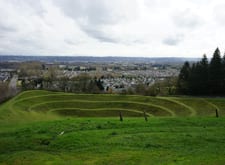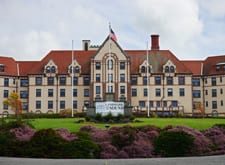2015 Endangered Properties
The Washington Trust for Historic Preservation announced its annual list of Most Endangered Historic Properties on Wednesday, May 6, 2015.
Three of the historic places on this year’s list are located in King County: Robert Morris Earthwork (SeaTac), Nuclear Reactor Building (Seattle), and the Masonic Home of Washington (Des Moines).
 Created in 1979, SeaTac’s Robert Morris Earthwork is a 4-acre sculpture and public artwork featured in numerous books, magazines, and publications. Its significance as a pioneering example of land reclamation as art has garnered an international audience of scholars, students, urban planners, curators and art enthusiasts. The Earthwork is one of the first publicly-funded artforms of this unique type in the United States and serves as a remarkable example of the ecological art movement created by one of America’s most recognized contemporary artists. As part of King County’s Public Art Collection, Robert Morris Earthwork is open to the public from dawn to dusk on a daily basis, providing a contemplative open space and an extraordinary view to the Kent Valley below.
Created in 1979, SeaTac’s Robert Morris Earthwork is a 4-acre sculpture and public artwork featured in numerous books, magazines, and publications. Its significance as a pioneering example of land reclamation as art has garnered an international audience of scholars, students, urban planners, curators and art enthusiasts. The Earthwork is one of the first publicly-funded artforms of this unique type in the United States and serves as a remarkable example of the ecological art movement created by one of America’s most recognized contemporary artists. As part of King County’s Public Art Collection, Robert Morris Earthwork is open to the public from dawn to dusk on a daily basis, providing a contemplative open space and an extraordinary view to the Kent Valley below.
Since its creation, the physical context of the Earthwork has changed dramatically as nearby urban development continues to expand. Encroaching development has also lead to more abuse of the sight, including vandalism and illegal dumping. 4Culture, King County’s cultural development entity is the designated steward of the Earthwork and would like to see it continue to benefit the community. Current funding provides for daily management of the site, but is insufficient for cleaning up vandalism, restoring the site from erosion, decomposition of natural features, or new interpretative signage. 4Culture is organizing a campaign to reach out nationally for funding toward site restoration and interpretation improvements to help local residents understand the importance of the Earthwork site. Efforts are also underway toward securing King County Landmark designation as well as listing in the National Register of Historic Places to help raise awareness and preserve the resource.
Following World War II, nuclear engineering programs proliferated at universities across the country, including the University of Washington. By 1958, the UW granted its first master’s degree in the field. Retaining a competitive Nuclear Engineering program, however, required construction of a research reactor.
Despite a policy that discouraged hiring university employees for campus design projects, University of Washington officials turned to The Architect Artist Group, known as “TAAG”, to design a building to house the new reactor: every member of the group, save one, was a UW professor at the time. Completed in 1961, the Nuclear Reactor Building, officially named More Hall Annex, stands as the only building project completed by TAAG and represents a unique collaboration between the architectural and the engineering departments. The building is also significant because it put nuclear technology on display so transparently: the glass-walled structure sits in an open plaza and before being de-commissioned allowed students to observe the activity taking place within.
In the Fall of 2014, the University unveiled plans to construct a new Computer Science and Engineering Building on the site, which would require demolition of the Nuclear Reactor Building. University officials are moving ahead with plans to prepare an Environmental Impact Statement for the proposed new structure, but to date have not considered the Nuclear Reactor Building’s inclusion in the National Register of Historic Places as reason enough to find an alternate location for the project. Advocates would like to see additional sites more thoroughly studied for construction of the new building. If no other sites can be found, advocates at very least want to see the Nuclear Reactor Building incorporated into the new development in a way that respects its unique architecture and historic significance.
 Completed in 1926 as a retirement community for members of Washington’s Masonic Society, the Masonic Home of Washington in Des Moines serves as a showcase for Masonry in Washington State. Designed by the architectural firm of Heath, Gove, and Bell, the building features box beam ceilings, hand carved woodwork, stained glass, and terrazzo floors throughout. The same architectural firm designed Stadium High School in Tacoma and Paradise Inn at Mt. Rainier, both of which are listed on the National Historic Register of Historic Places.
Completed in 1926 as a retirement community for members of Washington’s Masonic Society, the Masonic Home of Washington in Des Moines serves as a showcase for Masonry in Washington State. Designed by the architectural firm of Heath, Gove, and Bell, the building features box beam ceilings, hand carved woodwork, stained glass, and terrazzo floors throughout. The same architectural firm designed Stadium High School in Tacoma and Paradise Inn at Mt. Rainier, both of which are listed on the National Historic Register of Historic Places.
By 2004, the Masonic Grand Lodge of Washington, the sole owner, initiated plans to market the property as a traditional retirement home, open to Masons and non-Masons alike. But the economic recession put these plans on hold, leaving the building and its ornate facilities and beautiful grounds to instead be utilized as an event center hosting weddings, film shoots, and corporate meetings.
Given the high operating costs, the property was put up for sale in 2013 and event center operations ceased the following year. While there has been interest in the property, its future remains uncertain. The Masons have been exemplary stewards and the building’s architectural features and exterior remain in good condition. But many of the building’s systems are outdated, and modern code requirements, paired with the need to seismically retrofit the structure, will require substantial investment. The building does sit on a large parcel of land that could allow for in-fill development. A program of new construction coupled with rehabilitation could make the project financially feasible.
The remaining historic properties named to the 2015 Most Endangered List are St. Ignatius Hospital (Colfax), Longfellow School (Everett), and Lincoln School (Port Townsend). Descriptions of all six properties along with a video and digital images can be found on the Washington Trust’s website.
Since 1992, the independent, nonprofit Washington Trust for Historic Preservation has used its Most Endangered Historic Properties List to bring attention to over 100 threatened sites nominated by concerned citizens and organizations across the state. The Washington Trust assists advocates for these resources in developing strategies aimed at removing these threats, taking advantage of opportunities where they exist, and finding positive preservation solutions for listed resources.
Photos courtesy of the Washington Trust for Historic Preservation